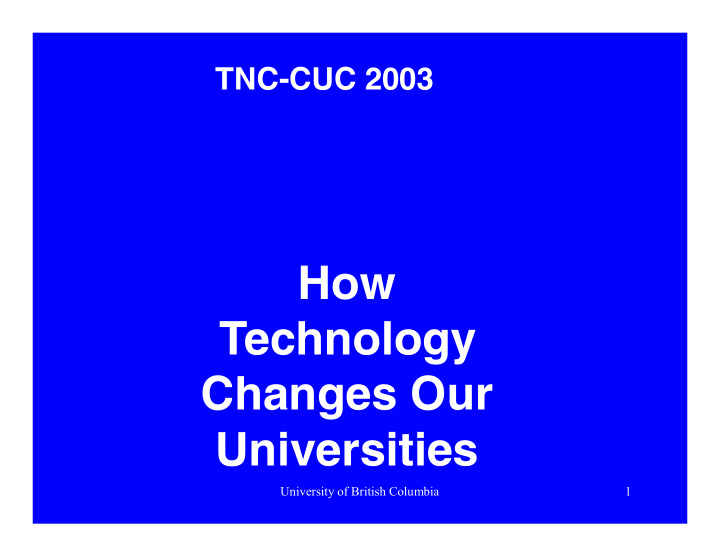



TNC-CUC 2003 How Technology Changes Our Universities University of British Columbia 1
Overview • 75 universities worldwide • strategies for e-learning • what is happening? • what is changing? • what needs to be done? University of British Columbia 2
Why use technology? • increase access/market share • improve quality of learning • higher level skills • knowledge/skills for knowledge-based society • save/make money University of British Columbia 3
Technology and flexible learning Distributed learning Face-to- face + Class- Face-to- e-learning Distance room face (mixed education aids teaching mode) Fully e-learning No e-learning University of British Columbia 4
Change depends on use • classroom aids • add-on • increases cost • distributed learning • replaces something • changes what we do University of British Columbia 5
Technology and choice • increases flexibility • brings new resources • facilitates skills development • offers more choice • so: what do we want to do? University of British Columbia 6
Vision • UBC: traditional public research university (35,000 students) • how do we want to teach? • faculty workshops • scenarios • summary video University of British Columbia 7
Vision: mandate • academic plan/strategic goals: • learner-centred • research teaching • problem/inq uiry based • collaborative • community linked University of British Columbia 8
Vision: mandate • lifelong learning • assume large classes • exploit existing campus • use ‘ known’ technology (exists or coming) • realistic re costs University of British Columbia 9
Teaching with technology • A vision for teaching with technology University of British Columbia 10
So what? • technology under-exploited • need to think strategically: • new markets: lifelong learning • new learning outcomes: PBL • improve q uality: Pew • re-organise to support e-learning University of British Columbia 11
Models of course design • Lone Ranger • boutiq ue • collegial materials development • project management University of British Columbia 12
Laissez-faire planning: “Lone Rangers” •main model everywhere •early adopters •essential for change •dedicated •no alternative University of British Columbia 13
’ Lone Rangers ‘ finished • often never k es • many mista , lengthy production / graphics • poor interface • limited use: lost revenues • put off other professors University of British Columbia 14
) T he diffusion of innovation % of adopters c b a d Resistance to adoption ( from Rogers, 1995 University of British Columbia 1 5
P ro j ect management j ects • establish pro k in a team • wor j ect e x pert + course developer + • sub web designer / budgets / courses • schedules k ed to • funding lin P M University of British Columbia 1 6
Lone Rangers vs project management Continuum class- distance multi- distributed room media education learning aids technical help more less change in methods University of British Columbia 1 7
P eople infrastructure • technical: k s / hardware • networ • production: • interface designers • graphics designers / management • instructional University of British Columbia 1 8
T he cycle of online development • 1. Lone rangers j ect grants • 2 . Central pro x pansion • 3. Rapid unco-ordinated e / policies / funding • 4. Focus • 5 . Q uality and sustainability University of British Columbia 1 9
Issues: high activity , low importance k s + terminals • networ • wireless / learning commons • computer labs j ects • learning ob • W eb streaming University of British Columbia 2 0
Issues: low activity , high importance strategy for e-learning goals cost- quality effectiveness teaching priorities funding policies learner support University of British Columbia 2 1
Q uality teaching and learning • outcomes-based k ills for k nowledge-based society • s , e.g. k ing • critical thin • problem-based learning • q uality assurance process University of British Columbia 2 2
q uality assurance Cost-effectiveness and q uality learning at reasonable cost • high • planning: strategic goals k et research • mar j ect management • pro • instructional design • accurate budgeting University of British Columbia 2 3
/ admin Integrating teaching k -end to student admin systems • bac / grades / e-mail addresses • class lists • portals • ‘ push ’ to students • customisable University of British Columbia 2 4
) ’ Integrated E-strategy / mar k eting / fund- • student recruitment raising / registration / materials • admission handling • courses + student record • portals ( user focused / strategy • needs ‘ middleware University of British Columbia 2 5
? W ill universities change • S ome have: • O pen University of Catalonia • T ec de onterrey M • University of Central Florida A ustralia • University of S outh University of British Columbia 2 6
? W ill universities change • ost won ’ t , because: k ing M • 1. Research is • 2 . No incentives k • 3. S enior administrators lac k nowledge / s k ills • 4. Necessary changes disruptive University of British Columbia 2 7
Conclusions • role of professors must change • pedagogy + organization the issues • not ready yet: still new • change will be slow: but necessary University of British Columbia 2 8
/ ( ‘ Further information • www.learningtechnologies. ubc.ca / bates.cstudies.ubc.ca • http: A A N A G ING • Bates , ) T ECHNO LO G IC A L CH A NG E 2 0 0 0 M ’ S an Francisco: Jossey Bass • tony.bates@ubc.ca University of British Columbia 2 9
Recommend
More recommend